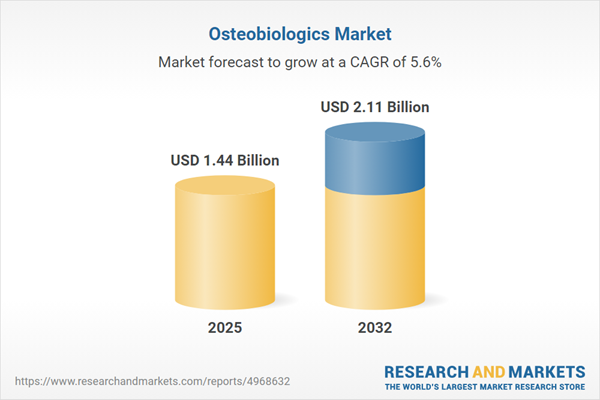Speak directly to the analyst to clarify any post sales queries you may have.
The osteobiologics market presents senior decision-makers with a complex environment shaped by regulatory change, cutting-edge innovation, and shifting healthcare demands. Executives must lead with agility, adopt resilient procurement strategies, and align operations to maintain a competitive advantage in this evolving field.
Osteobiologics Market Snapshot
The global osteobiologics market is projected to grow from USD 1.36 billion in 2024 to USD 1.44 billion in 2025, with a target of USD 2.11 billion by 2032, indicating a compound annual growth rate of 5.64%. This upward trajectory is fueled by growing adoption of musculoskeletal procedures, accelerated advances in biomaterial technology, and heightened competitive activity. Organizations are responding to changing global supply chain structures and evolving regulations, which requires leaders to maintain adaptability in procurement practices and remain receptive to divergent regional requirements. Strategic business alignment is increasingly vital for securing a durable foothold as the market evolves.
Scope & Segmentation in the Osteobiologics Market
This analysis arms senior executives with actionable intelligence for enhancing product offerings, supplier relationships, and market strategies across diverse osteobiologics applications. The segmentation and technology landscape outlined here supports effective benchmarking and decision-making, fostering competitive responses to emerging challenges and opportunities.
- Product Categories: Allograft solutions, available as freeze-dried or fresh frozen, are tailored for orthopedic and trauma repair. Bone morphogenetic proteins facilitate tissue regeneration. Synthetic grafts—hydroxyapatite, tricalcium phosphate, and demineralized bone matrix—provide multiple configuration options. Ceramic grafts leverage bioceramics and bioactive glasses. Cell-based approaches, drawing from autologous and allogenic sources, accommodate personalized surgical planning and diverse patient profiles.
- Technologies Utilized: Digital procurement platforms streamline ordering processes and strengthen clinical recordkeeping. Data analytics combined with advanced supply chain management tools enable healthcare providers to allocate resources efficiently, reducing operational waste and variability in care delivery.
- Geographical Coverage: Comprehensive regional analysis includes the Americas, EMEA, and Asia-Pacific markets. Key markets such as China, India, Japan, Australia, South Korea, and Southeast Asia are featured, spotlighting differences in reimbursement models, clinical infrastructure, and patient care priorities that drive local market adaptation.
- Key Suppliers Analyzed: Leading players encompass Medtronic plc, Johnson & Johnson, Stryker Corporation, Zimmer Biomet Holdings, Baxter International, Globus Medical, NuVasive, RTI Surgical, Orthofix Medical, and Exactech. The report evaluates how each supplier’s adaptability, sourcing strategies, and regulatory compliance influence procurement decision-making and mitigate risk.
Key Takeaways: Strategic Insights for Decision-Makers
- Integrating advanced orthopedic solutions enhances clinical workflow reliability while fostering better patient outcomes and greater operational consistency.
- Continual innovation in biomaterials and graft options expands treatable musculoskeletal conditions, offering organizations operational versatility in response to shifting care needs.
- Stronger clinical validation frameworks support collaboration among manufacturers, providers, and payers, encouraging the adoption of evidence-based procurement models for sustained market engagement.
- Deployment of data-driven procurement analytics optimizes supplier evaluation and improves risk management protocols, ensuring business continuity amid market fluctuations.
- Institutional investment in digital healthcare infrastructure correlates with quicker adoption of emerging technologies and supports ongoing modernization efforts in clinical settings.
- Digital supplier engagement tools reinforce supply chain stability, enhancing the ability to manage disruptions and ensure uninterrupted access to crucial surgical materials.
Tariff Impact: Supply Chain and Operational Effects
Recent tariff changes in the United States have prompted osteobiologics companies to reassess sourcing, inventory, and pricing strategies. This environment is accelerating the trend toward nearshoring, encouraging the adoption of flexible pricing structures, and stimulating demand for advanced analytics to keep supply chains stable and operations resilient in the face of regulatory uncertainty.
Methodology & Data Sources
Research findings are grounded in comprehensive desk research supplemented by insights from expert interviews with clinicians and supply chain specialists. Proprietary data is cross-referenced with third-party and public sources, ensuring the resulting guidance meets the practical needs of industry leaders in the osteobiologics market.
Why This Osteobiologics Market Report Matters
- Senior leaders gain a full spectrum of strategies to effectively steer product portfolios and procurement functions through evolving market and regulatory conditions.
- Procurement teams benefit from robust benchmarking and risk management tools designed to reduce exposure to supply chain and tariff-related disruptions.
- Healthcare providers receive targeted guidance for optimizing resource allocation, fostering informed competitive positioning within a competitive landscape.
Conclusion
Focused investment in technology, adaptive procurement models, and supplier collaboration equips organizations to harness new opportunities and build operational resilience as the osteobiologics market continues to evolve.
Additional Product Information:
- Purchase of this report includes 1 year online access with quarterly updates.
- This report can be updated on request. Please contact our Customer Experience team using the Ask a Question widget on our website.
Table of Contents
3. Executive Summary
4. Market Overview
7. Cumulative Impact of Artificial Intelligence 2025
Companies Mentioned
The companies profiled in this Osteobiologics market report include:- Medtronic plc
- Johnson & Johnson
- Stryker Corporation
- Zimmer Biomet Holdings, Inc.
- Baxter International Inc.
- Globus Medical, Inc.
- NuVasive, Inc.
- RTI Surgical, Inc.
- Orthofix Medical Inc.
- Exactech, Inc.
Table Information
| Report Attribute | Details |
|---|---|
| No. of Pages | 191 |
| Published | October 2025 |
| Forecast Period | 2025 - 2032 |
| Estimated Market Value ( USD | $ 1.44 Billion |
| Forecasted Market Value ( USD | $ 2.11 Billion |
| Compound Annual Growth Rate | 5.6% |
| Regions Covered | Global |
| No. of Companies Mentioned | 11 |









